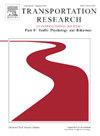Investigating simulator validity by using physiological and cognitive stress indicators
IF 4.4
2区 工程技术
Q1 PSYCHOLOGY, APPLIED
Transportation Research Part F-Traffic Psychology and Behaviour
Pub Date : 2025-07-08
DOI:10.1016/j.trf.2025.07.006
引用次数: 0
Abstract
Driving simulators are indispensable tools in modern automotive research and development. However, the transferability of findings to real-world driving, and thus, the validity of simulator-based results, cannot be assumed without empirical validation.
In this study, we examined physiological (Galvanic Skin Response-based measures, Electrocardiogram-based measures, salivary cortisol) and cognitive (NASA Task Load Index, Short Stress State Questionnaire, single-item ratings) stress indicators by comparing a real-world driving circuit with seven distinct sections to a medium-fidelity driving simulator, applying a Bayesian analytical approach. The results present a mixed picture, with both absolute and relative validity observed for certain physiological and cognitive stress indicators. Overall, our findings suggest that stress responses in the simulator and real-world driving are comparable, although the simulator was subjectively perceived as more stressful.
These results provide valuable insights into the validity of simulators for stress research and underscore the need to consider individual differences, experimental conditions, and methodological approaches in future studies.
利用生理和认知应激指标研究模拟器的有效性
驾驶模拟器是现代汽车研发中不可缺少的工具。然而,研究结果的可转移性到现实世界的驾驶,因此,基于模拟器的结果的有效性,不能假设没有经验验证。在这项研究中,我们采用贝叶斯分析方法,通过将真实世界的七个不同路段的驾驶电路与中等保真度的驾驶模拟器进行比较,研究了生理(基于皮肤电反应的测量,基于心电图的测量,唾液皮质醇)和认知(NASA任务负荷指数,短应激状态问卷,单项评分)压力指标。结果呈现出一幅复杂的画面,在某些生理和认知压力指标上观察到绝对和相对的有效性。总的来说,我们的研究结果表明,尽管模拟器在主观上被认为压力更大,但模拟器中的压力反应和现实驾驶中的压力反应是相似的。这些结果为应力研究模拟器的有效性提供了有价值的见解,并强调了在未来的研究中考虑个体差异、实验条件和方法方法的必要性。
本文章由计算机程序翻译,如有差异,请以英文原文为准。
求助全文
约1分钟内获得全文
求助全文
来源期刊
CiteScore
7.60
自引率
14.60%
发文量
239
审稿时长
71 days
期刊介绍:
Transportation Research Part F: Traffic Psychology and Behaviour focuses on the behavioural and psychological aspects of traffic and transport. The aim of the journal is to enhance theory development, improve the quality of empirical studies and to stimulate the application of research findings in practice. TRF provides a focus and a means of communication for the considerable amount of research activities that are now being carried out in this field. The journal provides a forum for transportation researchers, psychologists, ergonomists, engineers and policy-makers with an interest in traffic and transport psychology.

 求助内容:
求助内容: 应助结果提醒方式:
应助结果提醒方式:


